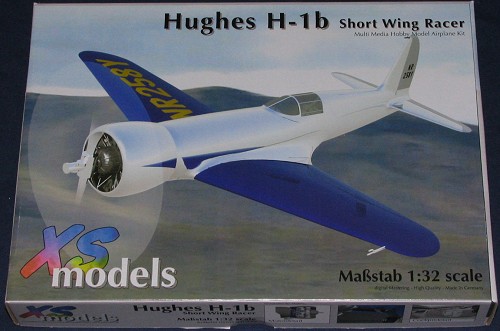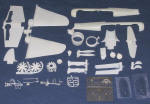
| KIT: | XS Models 1/32 Hughes H-1B (short wing) |
| KIT #: | 32012 |
| PRICE: | $ |
| DECALS: | One option |
| REVIEWER: | Scott Van Aken |
| NOTES: | Resin kit with photo etch, metal, and vacuform parts |

| HISTORY |
The Hughes H-1 racer was developed to be the fastest landplane in the world, It was designed by Howard Hughes and Richard Palmer and built by Glenn Odekirk. On September 13, 1935, Hughes achieved the design goal by flying the H-i to a new world speed record of 352.322 mph. The record was set over a specially instrumented course near Santa Ana, California.
Since Hughes did not require a sponsor for the aircraft, the H-i had no markings except the license number NR258Y (later NX 258Y) in chrome yellow against the dark blue background of the wings, and in black against the doped aluminum rudder. The fuselage was left in its natural polished aluminum finish. The H-i was powered by a Pratt and Whitney Twin Wasp Junior radial piston engine, which was rated at 700 horsepower at 8,500 feet but which could deliver 1,000 horsepower for high-speed flight. A wind tunnel model of the aircraft was exhaustively tested in the 200-mph wind tunnel at the California Institute of Technology’s Guggenheim Aeronautical Laboratory. Actual performance figures for the aircraft closely matched the predicted design performance.
 The H-1 had two
sets of wings, The wings Hughes used to break the land plane speed record
were of a low aspect ratio and shorter than those with which it is now
fitted. The wings now fitted on the aircraft span 31 feet, 9 inches. have a
moderate-aspect ratio, and were used when Howard Hughes broke the
transcontinental speed record in the H-i on January 19, 1937. Hughes
departed Los Angeles before dawn and arrived at Newark Airport, outside New
York City, 7 hours, 28 minutes, and 25 seconds later. His average speed
over the 2,490-mile course was 332 mph, and this nonstop flight was truly
an outstanding accomplishment.
The H-1 had two
sets of wings, The wings Hughes used to break the land plane speed record
were of a low aspect ratio and shorter than those with which it is now
fitted. The wings now fitted on the aircraft span 31 feet, 9 inches. have a
moderate-aspect ratio, and were used when Howard Hughes broke the
transcontinental speed record in the H-i on January 19, 1937. Hughes
departed Los Angeles before dawn and arrived at Newark Airport, outside New
York City, 7 hours, 28 minutes, and 25 seconds later. His average speed
over the 2,490-mile course was 332 mph, and this nonstop flight was truly
an outstanding accomplishment.
The Hughes H-1 was designed for record-setting purposes, but it also had an impact on the design of high-performance aircraft for years to come. Some of the outstanding design features of the H-1 were: a close fitting bell-shaped engine cowling to reduce airframe drag and improve engine cooling; gently curving wing fillets between the wing and the fuselage to help stabilize the airflow, reduce drag, and prevent potentially dangerous eddying and tail buffeting; retractable landing gear to reduce drag and increase speed and range (typical of everything for the H-1, the landing gear was so perfectly fitted that the gear fairings and doors are difficult to see without looking closely); all rivets and joints flush with the aircraft’s skin and flathead and counter-sunk screws on the plywood wings; ailerons designed to droop 15 degrees when this flaps are fully extended to improve lift along the full length of the wing during landing and takeoff; the pilot sitting in a smoothly faired and totally enclosed cockpit, which had an adjustable canopy windscreen to permit easy entry and exit from the aircraft.
The Hughes H-1 racer was a major milestone aircraft on the road to such radial engine-powered World War II fighters as the American Grumman F6F Hellcat and Republic P-47 Thunderbolt, the Japanese Mitsubishi Type 0 (Zero), and the German Focke-WuIf FW 190. It demonstrated that properly designed radial-engine aircraft could compete with the lower-drag inline designs despite having larger frontal areas because of their radial engine installations.
The H-1 was kept in the Hughes factory at Culver City, California, until it was donated to the Smithsonian Institution in 1975. It is now exhibited in the Golden Age of Flight gallery of the National Air and Space Museum.
| THE KIT |
 Opening the box, one is confronted
with several bags of parts. I appreciate this additional care from the
folks at XS Models, as this sort of packaging helps to protect the kit.
What's more, these were all wrapped in a layer of bubble wrap to protect
the parts during shipment. It seems to have worked just fine as I did not
have any broken bits.
Opening the box, one is confronted
with several bags of parts. I appreciate this additional care from the
folks at XS Models, as this sort of packaging helps to protect the kit.
What's more, these were all wrapped in a layer of bubble wrap to protect
the parts during shipment. It seems to have worked just fine as I did not
have any broken bits.
Overall the molding is pretty good. The detail level is quite nice, though it is a bit on the soft side when compared to a high pressure injection molded kit. When I and other reviewers talk about soft molding, we mean that the edges are not crisp 90 degree angles, but are somewhat rounded. This is a very common thing among most short run resin kits. I did find a few air bubbles on the edges of the stab and cowling, but nothing major. Parts with quite a bit of flash and mold junk were the engine and the exhaust. These will require considerable clean up. The engine sections have some resin build-up atop the cylinders in a few cases, but a few minutes with a motor tool will take care of these areas. In addition to the few air bubbles, there is a tad bit of pitting on the large parts, such as the wing.
Design of the kit is quite good. There is a separate lower insert for the cockpit section and the wings include the nicely detailed wheel wells and upper flap well. Flaps are provided separately and while this is a nice touch, all of the period photos I could find show the flaps raised. I'm sure this was a mechanical feature and not hydraulic or pneumatic so Hughes would have raised them for publicity photos. The kit does not include main landing gear as such for apparently they were housed inside the main gear doors. These doors are quite thick and should hold up the model without succumbing to the weight of it over the years.
The photo etched fret includes seat belts, instrument panel face, and the wiring for the P&W 1535 among other bits and pieces. The metal parts are for the rudder pedals, some engine bits, wheel hubs and a few other parts that I can't identify at the moment These are fairly well formed but will need some cleanup prior to use. Two nicely done vacuformed canopies are included, which is a real boon for those of us who tend to mess one up when working with them.
Instructions are a large folded sheet that includes a short history, a parts breakdown, an exploded diagram and eight nicely done construction steps. The construction steps are photo-realistic but, like all the images, reproduced at newspaper quality, which means they are not horribly distinct. There is a write-up that goes along with the various steps, written in both German and English. The English translation is nice to have, but doesn't really tell you much. For instance, in one step there are five lines in German taking up several sentences, while the English translation is less than a half line. Seems like something is missing. I know German takes a lot of letters to say things, but I don't think it is that extensive.
Decals are very nicely printed on what seems to be a solid carrier so some trimming will be necessary prior to use. Since the H-1 wasn't sponsored, one just has the registration and prop decals. Colors are a bare metal fuselage, aluminum doped control surfaces, and blue wings. The instructions say the short wings may have been red. An interesting supposition, but I've not read anything that might suggest this. No specific shade is provided for the blue, but it seems to me that it is a very dark shade, and I'll be checking out the automotive paints for a likely match.
| CONCLUSIONS |
Overall this appears to be a very nicely done kit. I've seen what may be one or two of these built up at the Atlanta Nationals and they were both stunning models. If your interests are in racers and you like large scale models, then this is a kit you should put on your want list. It is currently undergoing construction on my workbench, so a full build review will be forthcoming.
August 2005
| REFERENCES |
The Smithsonian Air and Space Museum www.nasm.ni.ed
Thanks go to RacePlaneDecals, the importers of this and other fine XS Model items for the preview kit. I don't believe they have a web site so e-mail them at RacePlaneDecals@aol.com for additional information and to order your kit.
If you would like your product reviewed fairly and quickly by a site that has around 300,000 visitors a month, please contact me or see other details in the Note to Contributors.